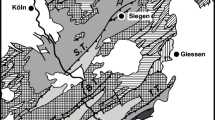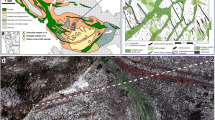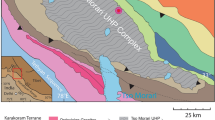Abstract
Unaltered metasediments of the Mary Kathleen Fold Belt are composed predominantly of layered amphibolite-facies scapolitic calc-silicate rocks in which minimal infiltration of externally derived fluids occurred during regional metamorphism. There were substantial differences in volatile activities between different layers in the layered sequences, in particular: a CO2/a H 2 O inferred from reaction progress estimates and analysis of biotite-clinopyroxene-fluid phase relations; a NaCl/a H 2 O inferred from scapolite compositions; and a HCl/a H 2 O inferred from biotite compositions. In one outcrop in which a clinopyroxene-producing reaction dominated, differences in approximate X CO 2of up to 0.25 occurred between several samples collected over 50 metres. Variations in a H 2 O/a HCl of up to one order of magnitude are inferred at 1 to 50 m scales from biotite-Cl contents, and variations in NaCl contents of scapolite from 0.0 to up to 0.6 Cl atoms in the Cl−CO3−SO4 site reflect a large variation of a NaCl in the coexisting fluid at similar scales. Most calcsilicate layers internally buffered fluid compositions in the H2O−CO2−NaCl−HCl system. Local occurrences of NaCl-rich scapolite suggest that some layers may have been in equilibrium with halite during early prograde metamorphism. At peak metamorphic temperatures, disolution of halite was complete but layers containing high-NaCl scapolite continued to buffer fluid at high values of a NaCl. Fluid immiscibility does not appear to have affected the progress of the devolatilization reactions. Although fluid was predominantly internally buffered, moderate quantities of fluid were released by prograde mineral reactions in many layers, up to 30 cm3 fluid per 100 cm3 rock. Numerous episodes of fluid escape were required, probably via microfractures, such that the released fluid did not obviously influence reaction progress in the layers through which it passed. The anomaly of beautifully preserved internal buffering signatures and the requirement for produced fluid locally to pass across layers in a deforming rock sequence suggest that the escaping fluid did not leave any readily observable tracks. This is explained by rapid rates of fracture propogation and fluid migration therein. This internally buffered system contrasts strongly with adjacent calc-silicate rocks that show evidence for infiltration of externally derived fluids at high fluid/rock ratios, and highlights the broad range of fluid behaviour that can be expected in deforming, heterogeneous rock sequences.
Similar content being viewed by others
References
Bowers TS, Helgeson HC (1983a) Calculation of the thermodynamic and geochemical consequences of nonideal mixing in the system H2O−CO2−NaCl on phase relations in geologic systems: equation of state for H2O−CO2−NaCl fluids at high pressures and temperatures. Geochim Cosmochim Acta 47:1247–1275
Bowers TS, Helgeson HC (1983b) Calculation of the thermodynamic and geochemical consequences of nonideal mixing in the system H2O−CO2−NaCl on phase relations in geologic systems: metamorphic equilibria at high pressures and temperatures. Am Mineral 68:1059–1075
Brown PE, Lamb WM (1989) P-V-T properties of fluids in the system H2O±CO2±NaCl: new graphical presentations and implications for fluid inclusion studies. Contrib Mineral Petrol 53:1209–1221
Cawthorn RG, Collerson KD (1974) The recalculation of pyroxene end-member parameters and the estimation of ferrous and ferric iron content from electron microprobe analyses. Am Mineral 59:1203–1208
Cox SF, Etheridge MA (1989) Coupled grain-scale dilatancy and mass transfer during deformation at high fluid pressures: examples from Mount Lyell, Tasmania. J Struct Geol 11:147–162
Derrick GM, Wilson IH, Hill RM, Mitchell JE (1971) Geology of the Marraba 1:100 000 sheet area, Queensland (unpubl). Bur Miner Resour, Geol Geophys Record 1971/56
Ellis DE (1978) Stability and phase equilibria of chloride and carbonate bearing scapolites at 750°C and 4000 bar. Geochim Cosmochim Acta 42:1271–1281
Etheridge MA, Wall VJ, Vernon RH (1983) The role of the fluid phase during regional metamorphism and deformation. J Metamorphic Geol 1:205–226
Evans BW, Shaw DM, Haughton DR (1969) Scapolite stoichiometry. Contrib Mineral Petrol 24:293–305
Ferry JM (1976) Metamorphism of calcarareous metasediments in the Waterville-Augusta area, south-central Maine: mineral reactions and graphical analysis. Am J Sci 276:841–882
Ferry JM (1979) A map of chemical potential differences within an outcrop. Am Mineral 64:966–985
Ferry JM (1986) Infiltration of aqucous fluid and high fluid: rock ratios during greenschist-facies metamorphism: a reply. J Petrol 27:695–714
Ferry JM (1987) Metamorphic hydrology at 13 km depth and 400°C–550°C. Am Mineral 72:39–58
Goldsmith JR, Newton RC (1977) Scapolite-plagioclase stability relations at high pressures and temperatures in the system NaAlSi3O8−CaAl2Si2O8−CaCO3−CaSO4. Am Mineral 62: 1063–1081
Greenwood HJ (1975) Buffering of pore fluid by metamorphic reactions. Am J Sci 275:573–594
Guidotti CV (1984) Micas in metamorphic rocks. In: Bailey SW (ed) Micas. (Reviews in Mincralogy 13) Mineral Soc Am, Washington, D.C., pp 357–468
Heitenan A (1967) Scapolite in the Belt series in the St. Joe-Clearwater region, Idaho. Geol Soc Am Spec Pap 86
Helgeson HC, Brown TH, Nigrini A, Jones TA (1970) Calculation of mass transfer in geochemical processes involving aqueous solutions. Geochim Cosmochim Acta 34:569–592
Hewitt DA (1973) The metamorphism of micaceous limestones from south-central Connecticut. Am J Sci 273-A:444–469
Leake BE (1978) Nomenclature of amphiboles. Am Mineral 60:1047–1062
Leelanandam C (1969) H2O+, F and Cl in the charnocitic bioties from Kondapilli, India. Neues Jahrb Mineral Monatsh 10:461–468
Mora C, Valley J (1989) Halogen-rich scapolite and biotite: implications for metamorphic fluid-rock interaction. Am Mineral 74:721–737
Munoz JL (1984) F−OH and Cl-OH exchange in micas with applications to hydrothermal ore deposits. In: Bailey SW (ed) Micas. (Reviews in Mineralogy 13) Mineral Soc Am, Washington, DC, pp 469–494
Munoz JL, Swenson A (1981) Chloride-hydroxyl exchange in biotite and estimation of relative HCl/HF activities in hydrothermal fluids. Econ Geol 76:2212–2221
Oliver NHS (1988) A metamorphic plumbing system — the Mary Kathleen Fold Belt, northwest Queensland (unpubl). PhD Thesis Monash University
Oliver NHS, Wall VJ (1986) Scapolite parageneses in calc-silicates and metadolerites from Mary Kathleen, NW Queensland: implications for metamorphic fluid evolution (abstract). Geol Soc Aust Abstr 15:147–148
Oliver NHS, Wall VJ (1987) Metamorphic plumbing system in Proterozoic calc-silicates, Queensland, Australia. Geology 15:793–796
Oliver NHS, Valenta RK, Wall VJ (1990a) The effect of heterogeneous stress and strain on metamorphic fluid flow, Mary Kathleen, Australia, and a model for large-scale fluid circulation. J Metamorphic Geol 8:311–331
Oliver NHS, Wall VJ, Golding SD (1990b) Heterogeneous fluid flow in polydeformed calc-silicates of the Mary Kathleen Fold Belt. In: Herbert HK, Ho SE (eds) Stable isotopes and fluid processes in mineralisation. Geol Dept Univ Extension, Univ Western Aust 23:290–314
Oliver NHS, Holcombe RJ, Hill EJ, Pearson PJ (1991) Tectonometamorphic evolution of the Mary Kathleen Fold Belt, northwest Queensland: a reflection of mantle plume processes? Aust J Earth Sci 38:425–455
Orville PM (1975) Stability of scapolite in the system Ab−An−NaCl−CaCO3 at 4 kbar and 750°C. Geochim Cosmochim Acta 39:1091–1105
Oterdoom WH, Gunter WD (1983) Activity models for plagioclase and CO3-scapolites — an analysis of field and laboratory data. Am J Sci 283-A:255–282
Page RW (1978) Response of U-Pb zircon and Rb-Sr total-rock and mineral systems to low-grade regional metamorphism in proterozoic igneous rocks, Mount Isa, Australia. J Geol Soc Aust 25:141–164
Powell R, Holland TJB (1988) An internally consistent thermodynamic dataset with uncertainties and correlations: 3. Applications to geobarometry, worked examples and a computer program. J Metamorphic Geol 6:173–204
Ramsay CR, Davidson LR (1970) The origin of scapolite in regionally metamorphosed rocks, Mary Kathleen, Queensland, Australia. Contrib Mineral Petrol 25:41–51
Rice JM, Ferry JM (1982) Buffering, infiltration, and the control of intensive variables during metamorphism. In: Ferry JM (ed) Characterization of metamorphism through mineral equilibria. (Reviews in Mineralogy 10) Mineral Soc Am, Washington, DC, pp 263–326
Rumble D III (1977) Mineralogy, petrology, and oxygen isotope geochemistry of the Clough Formation, Black Mountain, Western New Hampshire, USA. J Petrol 19:317–340
Serdyuchenko DP (1975) Some Precambrian scapolite-bearing rocks evolved from evaporites. Lithos 8:1–7
Sibson RH (1987) Earthquake rupturing as a mineralising agent in hydrothermal systems. Geology 15:701–704
Sibson RH, Moore J, Rankin AH (1975) Seismic pumping — a hydrothermal fluid transport mechanism. J Geol Soc London 131:653–609
Skippen G, Trommsdorf V (1986) The influence of NaCl and KCl on phase relations in metamorphosed carbonate rocks. Am J Sci 286:81–104
Thompson AB (1975a) Calc-silicate diffusion zones between marble and pelitic schist. J Petrol 16:314–346
Thompson AB (1975b) Mineral reactions in a calc-mica schist from Gassets, Vermont, USA. Contrib Mineral Petrol 53:105–127
Valley JW (1986) Stable isotope geochemistry of metamorphic rocks. In: (Reviews in Mineralogy 16) Mineral Soc Am. Valley JW, Taylor HP Jr, O'Neil JR (eds) Stable isotopes in high temperature geological processes. Washington, DC, pp 445–490
Valley JW, O'Neil JR (1984) Fluid heterogenicity during granulite facies metamorphism in the Adirondacks: stable isotope evidence. Contrib Mineral Petrol 85:158–173
Vanko DA (1986) High-chlorine amphiboles from oceanic rocks: product of highly saline hydrothermal fluids? Am Mineral 71:51–59
Vanko DA, Bishop FC (1982) Occurrence and origin of marialitic scapolite in the Humboldt Lopolith, N.W. Nevada. Contrib Mineral Petrol 81:277–289
Volfinger M, Robert J, Vielzeuf D, Neiva AMR (1985) Structural control of the chlorine content of OH-bearing silicates (micas and amphiboles). Geochim Cosmochim Acta 49:37–48
Walther JV, Orville PM (1982) Volatile production and transport in regional metamorphism. Contrib Mineral Petrol 79:252–257
Wood BJ, Graham CM (1986) Infiltration of aqueous fluid and high fluid: rock ratios during greenschist facies metamorphism: a discussion. J Petrol 27:751–761
Wood BJ, Nicholls J (1978) The thermodynamic properties of reciprocal solid solutions. Contrib Mineral Petrol 66:389–400
Wood BJ, Walther JV (1986) Fluid flow during metamorphism and its implications for fluid-rock ratios. In: Walther JV, Wood BJ (eds) Fluid-rock interactions during metamorphism. Springer, Berlin Heidelberg New York, pp. 89–108
Yardley BWD (1986) Fluid migration and veining in the Connemara Schists, Ireland. In: Walther JV, Wood BJ (eds) Fluid-rock interactions during metamorphism. Springer, Berlin Heidelberg, New York, pp 109–131
Author information
Authors and Affiliations
Rights and permissions
About this article
Cite this article
Oliver, N.H.S., Wall, V.J. & Cartwright, I. Internal control of fluid compositions in amphibolite-facies scapolitic calc-silicates, Mary Kathleen, Australia. Contrib Mineral Petrol 111, 94–112 (1992). https://doi.org/10.1007/BF00296581
Received:
Accepted:
Issue Date:
DOI: https://doi.org/10.1007/BF00296581




